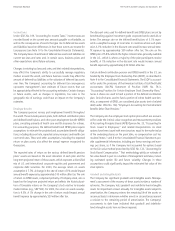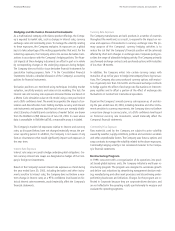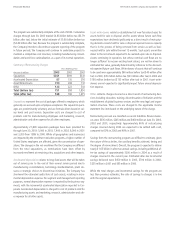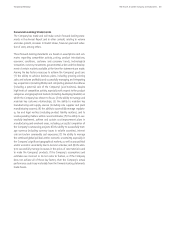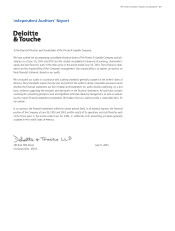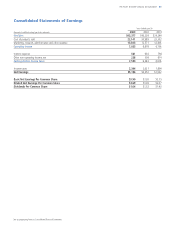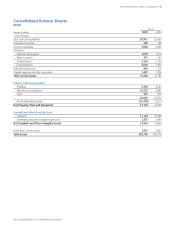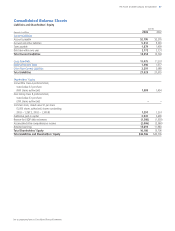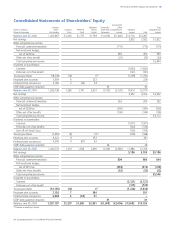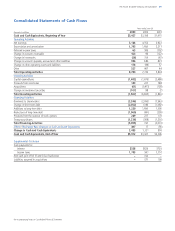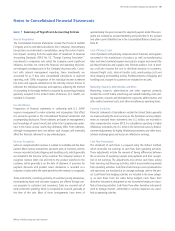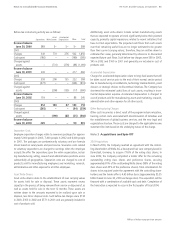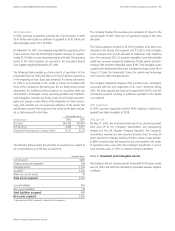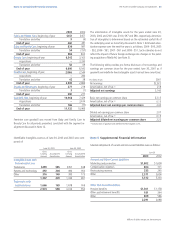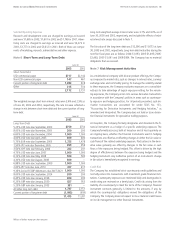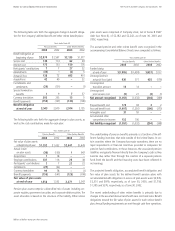Proctor and Gamble 2003 Annual Report Download - page 42
Download and view the complete annual report
Please find page 42 of the 2003 Proctor and Gamble annual report below. You can navigate through the pages in the report by either clicking on the pages listed below, or by using the keyword search tool below to find specific information within the annual report.40The Procter & Gamble Company and Subsidiaries
Notes to Consolidated Financial Statements
approximately one year. Accruals for expected payouts under these pro-
grams are included as accrued marketing and promotion in the accrued
and other current liabilities line in the Consolidated Balance Sheets (see
Note 5).
Cost of Products Sold
Cost of products sold primarily comprises direct materials and supplies
consumed in the manufacture of product, as well as manufacturing
labor and direct overhead expense necessary to acquire and convert the
purchased materials and supplies into finished product. Cost of prod-
ucts sold also includes the cost to distribute products to customers,
inbound freight costs, internal transfer costs, warehousing costs and
other shipping and handling activity. Reimbursements of shipping and
handling costs charged to customers are included in net sales.
Marketing, Research, Administrative and Other
Marketing, research, administrative and other expenses primarily
include: the cost of media, advertising and related marketing costs; sell-
ing expenses; research and development; corporate, administrative and
other indirect overhead costs; and other miscellaneous operating items.
Currency Translation
Financial statements of subsidiaries outside the United States generally
are measured using the local currency as the functional currency. Adjust-
ments to translate those statements into U.S. dollars are recorded in
other comprehensive income (OCI). For subsidiaries operating in highly
inflationary economies, the U.S. dollar is the functional currency. Remea-
surement adjustments for highly inflationary economies and other trans-
actional exchange gains and losses are reflected in earnings.
Cash Flow Presentation
The statement of cash flows is prepared using the indirect method,
which reconciles net earnings to cash flow from operating activities.
These adjustments include the removal of timing differences between
the occurrence of operating receipts and payments and their recogni-
tion in net earnings. The adjustments also remove cash flows arising
from investing and financing activities, which are presented separately
from operating activities. Cash flows from foreign currency transactions
and operations are translated at an average exchange rate for the peri-
od. Cash flows from hedging activities are included in the same catego-
ry as cash flows from the items being hedged. Cash flows from
derivative instruments designated as net investment hedges are classi-
fied as financing activities. Cash flows from other derivative instruments
used to manage interest, commodity or currency exposures are classi-
fied as operating activities.
Note 1 Summary of Significant Accounting Policies
Basis of Presentation
The Consolidated Financial Statements include The Procter & Gamble
Company and its controlled subsidiaries (the Company). Intercompany
transactions are eliminated in consolidation, except for certain transla-
tion impacts resulting from the application of Statement of Financial
Accounting Standards (SFAS) No. 52, “Foreign Currency Translation.”
Investments in companies over which the Company exerts significant
influence, but does not control the financial and operating decisions,
are managed as integral parts of the Company’s business units. Consis-
tent with internal management reporting, these investments are
accounted for as if they were consolidated subsidiaries in segment
reporting, with 100% recognition of the individual income statement
line items and separate elimination of the minority interest. Entries to
eliminate the individual revenues and expenses, adjusting the method
of accounting to the equity method as required by accounting principles
generally accepted in the United States of America (U.S. GAAP), are
included in Corporate.
Use of Estimates
Preparation of financial statements in conformity with U.S. GAAP
requires management to make estimates and assumptions that affect
the amounts reported in the Consolidated Financial Statements and
accompanying disclosures. These estimates are based on management’s
best knowledge of current events and actions the Company may under-
take in the future. Actual results may ultimately differ from estimates,
although management does not believe such changes will materially
affect the financial statements in any individual year.
Revenue Recognition
Sales are recognized when revenue is realized or realizable and has been
earned. Most revenue transactions represent sales of inventory, and the
revenue recorded includes shipping and handling costs, which generally
are included in the list price to the customer. The Company’s policy is to
recognize revenue when risk and title to the product transfers to the
customer, which generally is on the date of shipment. A provision for
payment discounts and product return allowances is recorded as a
reduction of sales within the same period that the revenue is recognized.
Trade promotions, consisting primarily of customer pricing allowances,
merchandising funds and consumer coupons, are offered through vari-
ous programs to customers and consumers. Sales are recorded net of
trade promotion spending, which is recognized as incurred, generally at
the time of the sale. Most of these arrangements have terms of
Millions of dollars except per share amounts


